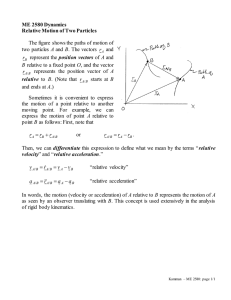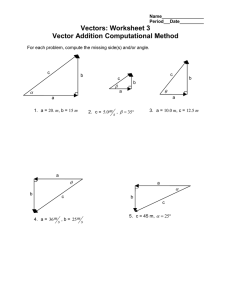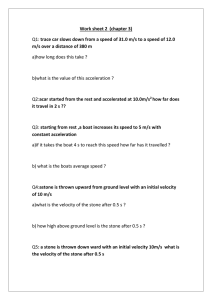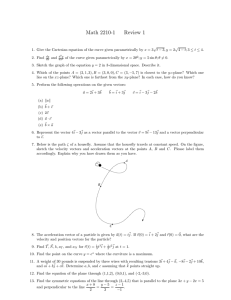CT1-1. Can two vectors of unequal magnitude sum
advertisement
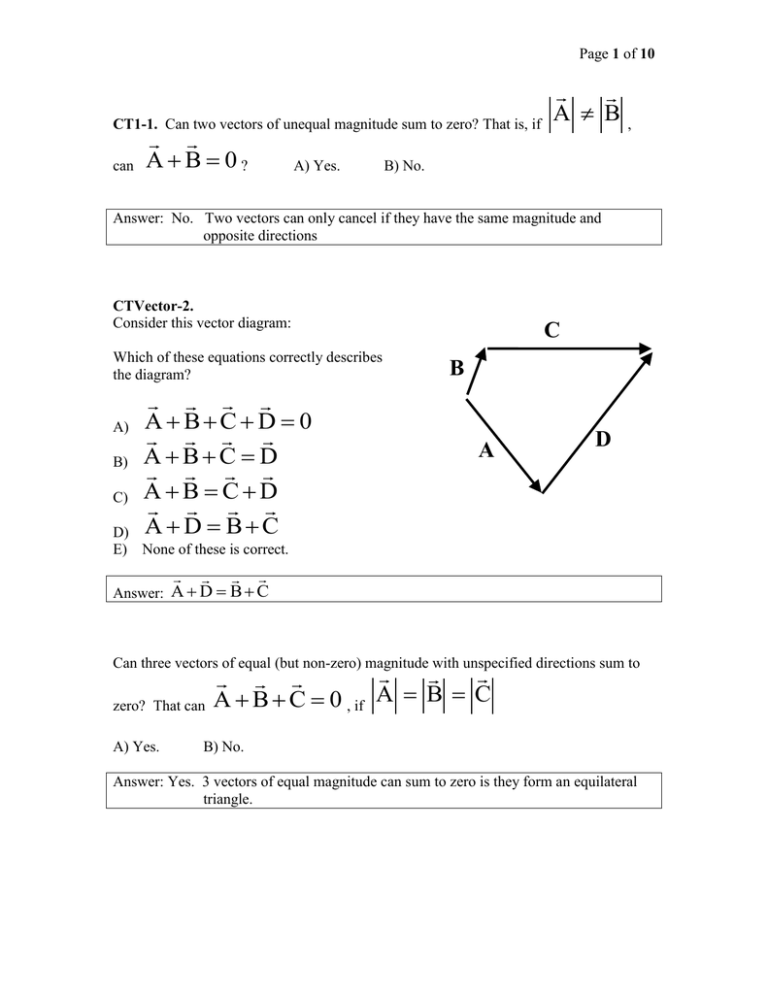
Page 1 of 10 CT1-1. Can two vectors of unequal magnitude sum to zero? That is, if can AB 0? A) Yes. A B , B) No. Answer: No. Two vectors can only cancel if they have the same magnitude and opposite directions CTVector-2. Consider this vector diagram: Which of these equations correctly describes the diagram? A) B) C) A BC D 0 A BC D AB CD A D BC C B A D D) E) None of these is correct. Answer: A D B C Can three vectors of equal (but non-zero) magnitude with unspecified directions sum to zero? That can A) Yes. A B C 0 , if A B C B) No. Answer: Yes. 3 vectors of equal magnitude can sum to zero is they form an equilateral triangle. Page 2 of 10 CT1-3. Vectors Vectors What is A) C) D) A, B, and C sum to zero, which means A B C 0 . A and B C C? A+B are at right angles to each other ( A B ). B) A–B A 2 B2 Impossible to tell from the information given. Answer: C. Draw the vector diagram and use Pythagorean Theorem. Page 3 of 10 CT1-4. Three vectors A , B, and C are as shown. Which vector is S A B C ? B C A (A) (B) (C) (E) None of these. Answer: None of these. The x-component of S is Sx = +1 (D) Page 4 of 10 CT1-5. The solid line has length A and makes an angle with the negative y-axis. What is the length of the dotted line? A) A cos y B) A sin C) A tan D) sin/A A x E) cos/A Answer: A) The length of the dotted line is A cos. Remember: “cozy side”. The ycomponent of A is Ay = A cos. CT1-6. What is the correct formula for Ay, the y-component of the vector A) +A cos A? y B) +A sin C) –A cos D) –A sin E) None of these. A Answer: –A cos Get the sign by looking at the diagram. x Page 5 of 10 CT1-7. The vectors is A, B, and C are shown. The vector sum of these three vectors S=A+B+C What is the value of Sx, the x-component of S ? A) +2 A B) – 4 B C C) – 2 D) +3 E) None of these Answer: None of these. Sx = –3 What is Sy , the y-component of S? (Same choices) Answer: –4 Page 6 of 10 CT1-8. How many of these equation make no sense? A) 0 A ˆj B 3iˆ ˆj 5jˆ A C 3 C A ˆi C 4 ˆi (All make sense) B) 1 C) 2 D) 3 E) 4 Answer: The last statement makes no sense. You cannot add a vector and a number. All the other statements are perfectly valid. Page 7 of 10 CT1-9. The position vector of a particle moving with constant velocity is shown below at two different times, an earlier time t1 and a later time t2. Which arrow shows the direction of the velocity vector? R1 (A) (B) (E) None of these! R2 (C) (D) Answer: B. The object is moving to the right. Vector R is to the right, so vector v is to the right. Page 8 of 10 CT1-10. The velocity vector of a particle moving with constant acceleration is shown below at two different times, an earlier time t1 and a later time t2. What is the direction of the acceleration vector? V1 (A) (B) (C) (E) None of these! V2 (D) Answer: C The direction of the acceleration is down. Draw the V1-V2-deltaV diagram! Page 9 of 10 CT1-11. Which diagram below correctly depicts the equation A) v1 B) v C) v1 v2 D) all three (A,B,C) are correct v1 v v2 ? v v2 v1 v v2 E) None (A,B,C) are correct Answer: Only diagram A is correct. CT1-12. On the PhET sim Lunar Lander, which arrow is velocity and which is acceleration? A) green is velocity, yellow is acceleration B) yellow is velocity, green is acceleration C) both are velocity D) both are acceleration E) one of the arrows is velocity, but the other arrow is something other than acceleration Answer: green is velocity, yellow is acceleration CT1-13. Two stones are dropped into a bottomless pit, the second stone is dropped 2 seconds after the first stone. Assume no air resistance. Down is chosen as the positive direction so the velocity of stone 1 is v1 = g t (t = 0 when stone 1 is dropped.) What is the correct expression for the velocity of stone 2 after it is dropped? A) v2 = g t B) v2 = g (t 2 s) C) v2 = g (t + 2 s) D) None of these Answer: v2 = g (t 2 s) This is the only equation which gives the right answer v2 = 0 at t = 2 s. As both stones fall, the difference in their velocities.. A) increases B) decreases C) remains constant Answer: Remains constant. This is a tough one. Set t=0 when the first stone falls. I’ll pick downward as the (+) direction, so that the velocities are positive. After a time t, the velocity of the first stone is v1 = gt, and the velocity of the 2nd stone is v2 = g(t - 2s). Page 10 of 10 So the difference, at any time, is (v1–v2) = +g(2 s) which is constant. As both stones fall, the difference in their heights (y-positions).. A) increases B) decreases C) remains constant Answer: increases. Since stone 1 always has a larger velocity [ larger by +g(2 s) ], the difference in heights is always increasing.

